ZHCSEI6 January 2016 LM5140-Q1
PRODUCTION DATA.
- 1 特性
- 2 应用
- 3 说明
- 4 简化电路原理图
- 5 修订历史记录
- 6 Pin Configuration and Functions
- 7 Specifications
-
8 Detailed Description
- 8.1 Overview
- 8.2 Functional Block Diagram
- 8.3
Feature Description
- 8.3.1 High Voltage Start-up Regulator
- 8.3.2 VCC Regulator
- 8.3.3 Oscillator
- 8.3.4 SYNIN and SYNOUT
- 8.3.5 Enable
- 8.3.6 Power Good
- 8.3.7 Output Voltage
- 8.3.8 Minimum Output Voltage Adjustment
- 8.3.9 Current Sense
- 8.3.10 DCR Current Sensing
- 8.3.11 Error Amplifier and PWM Comparator
- 8.3.12 Slope Compensation
- 8.4 Device Functional Modes
- 9 Application and Implementation
- 10Power Supply Recommendations
- 11Layout
- 12器件和文档支持
- 13机械、封装和可订购信息
7 Specifications
7.1 Absolute Maximum Ratings
Over operating free-air temperature range (unless otherwise noted)(1)| MIN | MAX | UNIT | ||
|---|---|---|---|---|
| Input voltage | VIN | -0.3 | 70 | V |
| SW1,SW2 to PGND | -0.3 | 70 | V | |
| SW1, SW2 to PGND (20ns transient) | -5 | V | ||
| HB1 to SW1, HB2 to SW2 | -0.3 | 6.5 | V | |
| HB1 to SW1, HB2 to SW2 (20ns transient) | -5 | V | ||
| HO1 to SW1, HOL1 to SW1, HO2 to SW2, HOL2 to SW2 | -0.3 | HB + 0.3 | V | |
| HO1 to SW1, HOL1 to SW1, HO2 to SW2, HOL2 to SW2 (20ns transient) | -5 | V | ||
| LO1, LOL1, LO2, LOL2 to PGND | -0.3 | VCC + 0.3 | V | |
| LO1, LOL1, LO2, LOL2 to PGND ( 20ns transient) | -1.5 | VCC + 0.3 | V | |
| OSC, SS1, SS2, COMP1, COMP2, RES, DEMB, ILSET | -0.3 | VDDA + 0.3 | V | |
| EN1, EN2 to PGND | -0.3 | 70 | V | |
| VCC, VCCX, VDDA, PG1, PG2, FB1, FB2, SYNIN | -0.3 | 6.5 | V | |
| VOUT1, VOUT2, CS1, CS2 | -0.3 | 15.5 | V | |
| VOUT1 to CS1, VOUT2 to CS2 | -0.3 | 0.3 | V | |
| PGND to AGND | -0.3 | 0.3 | V | |
| Operating Junction Temperature(2) | –40 | 150 | ºC | |
| Storage temperature, Tstg | –40 | 150 | °C | |
(1) Stresses beyond those listed under Absolute Maximum Ratings may cause permanent damage to the device. These are stress ratings only, which do not imply functional operation of the device at these or any other conditions beyond those indicated under Recommended Operating Conditions. Exposure to absolute-maximum-rated conditions for extended periods may affect device reliability.
(2) High junction temperatures degrade operating lifetimes. Operating lifetime is de-rated for junction temperatures greater than 125°C.
7.2 ESD Ratings
| VALUE | UNIT | ||||
|---|---|---|---|---|---|
| V(ESD) | Electrostatic discharge | Human-body model (HBM), per AEC Q100-002(1)(2) | ±2000 | V | |
| Charged-device model (CDM), per AEC Q100-011(3) | All pins | ±500 | |||
| Corner pins | ±750 | ||||
(1) AEC Q100-002 indicates that HBM stressing shall be in accordance with the ANSI/ESDA/JEDEC JS-001 specification.
(2) Level listed above is the passing level per ANSI/ESDA/JEDEC JS-001. JEDEC document JEP155 states that 500 V HBM allows safe manufacturing with a standard ESD control process.
(3) Level listed above is the passing level per EIA-JEDEC JESD22-C101. JEDEC document JEP157 states that 250 V CDM allows safe manufacturing with a standard ESD control process.
7.3 Recommended Operating Conditions(1)
over operating free-air temperature range (unless otherwise noted)| MIN | NOM | MAX | UNIT | |||
|---|---|---|---|---|---|---|
| VIN | Input voltage range | VIN | 3.8 | 65 | V | |
| SW1, SW2 to PGND | –0.3 | 65 | V | |||
| HB1 to SW1, HB2 to SW2 | –0.3 | 5 | 5.25 | V | ||
| HO1 to SW1, HOL1 to SW1, HO2 to SW2, HOL2 to SW2 | –0.3 | HB + 0.3 | V | |||
| LO1, LOL1, LO2, LOL2 to PGND | –0.3 | 5 | 5.25 | V | ||
| FB1, FB2, PG1, PG2, SYNIN, OSC, SS1, SS2, RES, DEMB, VCCX, ILSET | –0.3 | 5 | V | |||
| EN1, EN2 to PGND | –0.3 | 65 | V | |||
| VCC, VDDA | –0.3 | 5 | 5.25 | V | ||
| VOUT1, VOUT2, CS1, CS2 | 1.5 | 5 | 15 | V | ||
| VO | Output voltage range | SYNOUT | –0.3 | 5.25 | V | |
| PGND to AGND | –0.3 | 0.3 | V | |||
| TJ | Operating Junction Temperature(2) | –40 | 150 | °C | ||
(1) Recommended Operating Conditions are conditions under which the device is intended to be functional. For specifications and test conditions, see the Electrical Characteristics.
(2) High junction temperatures degrade operating lifetimes. Operating lifetime is de-rated for junction temperatures greater than 125°C.
7.4 Thermal Information
| THERMAL METRIC(1) | LM5140-Q1 | UNIT | |
|---|---|---|---|
| VQFN (RWG) | |||
| 40 PINS | |||
| RθJA | Junction-to-ambient thermal resistance | 34.8 | °C/W |
| RθJC(top) | Junction-to-case (top) thermal resistance | 22.8 | °C/W |
| RθJB | Junction-to-board thermal resistance | 9.5 | °C/W |
| ψJT | Junction-to-top characterization parameter | 1.3 | °C/W |
| ψJB | Junction-to-board characterization parameter | 9.4 | °C/W |
| RθJC(bot) | Junction-to-case (bottom) thermal resistance | 0.3 | °C/W |
(1) For more information about traditional and new thermal metrics, see the Semiconductor and IC Package Thermal Metrics application report, SPRA953.
7.5 Electrical Characteristics
TJ = –40°C to 125°C, VIN = 12 V, VCCX = 5 V, VOUT1 = 3.3 V, VOUT2 = 5 V, EN1 = EN2 = 5 V, OSC = VDDA, SYNIN = 0 V, FSW = 2.2 MHz, no-load on the Drive Outputs (HO1, HOL1, LO2, LOL1, HO2, HOL2, LO2, and LOL2 outputs) (unless otherwise noted). (1)(2)| PARAMETER | TEST CONDITIONS | MIN | TYP | MAX | UNIT | |
|---|---|---|---|---|---|---|
| VIN SUPPLY VOLTAGE | ||||||
| I(SHUTDOWN) | Shutdown mode current | VIN 8 V- 18 V, EN1 = 0 V, EN2 = 0 V, VCCX = 0 V | 9 | 12.5 | µA | |
| I(STANDBY) | Standby Current | EN1 = 5 V, EN2 = 0 V, VOUT1, in regulation, no-load, not switching. VIN 8 V - 18 V. DEMB = GND |
35 | µA | ||
| Or EN1 = 0 V, EN2 = 5 V, VOUT2 in regulation, no-load, not switching, VOUT2 connected to VCCX, DEMB = GND. |
42 | µA | ||||
| VCC REGULATOR | ||||||
| VCC(REG) | VCC regulation voltage | VIN = 6 V - 18 V, 0 - 150 mA, VCCX = 0 V |
4.75 | 5.0 | 5.25 | V |
| VCC(UVLO) | VCC under voltage threshold | VCC rising, VCCX = 0 V | 3.25 | 3.4 | 3.55 | V |
| VCC(HYST) | VCC hysteresis voltage | VCCX = 0 V | 175 | mV | ||
| ICC(LIM) | VCC sourcing current limit | VCCX = 0 V | 170 | 250 | mA | |
| VDDA | ||||||
| VDDA(REG) | Internal bias supply power | VCCX = 0 V | 4.75 | 5.0 | 5.25 | V |
| VDDA(UVLO) | VCC rising, VCCX = 0 V | 3.1 | 3.2 | 3.3 | V | |
| VDDA(HYST) | VCCX = 0 V | 180 | mV | |||
| R(VDDA) | VCCX = 0 V | 50 | Ω | |||
| VCCX | ||||||
| VCCX(ON) | VCC rising | 4.1 | 4.3 | 4.4 | V | |
| R(VCCX) | VCCX = 5 V | 1 | Ω | |||
| VCCX(HYST) | 200 | mV | ||||
| OSCILLATOR SELECT THRESHOLDS | ||||||
| 2.2 MHz Oscillator select threshold | (OSC pin) | 2.4 | V | |||
| 440 kHz Oscillator select threshold | (OSC pin) | 0.4 | V | |||
| CURRENT LIMIT | ||||||
| V(CS1) | Current limit threshold1 | ILSET = VDDA, Measure from CS to VOUT |
66 | 73 | 80 | mV |
| V(CS2) | Current limit threshold2 | ILSET = GND, Measure from CS to VOUT |
44 | 48 | 53 | mV |
| Current sense delay to output | 40 | ns | ||||
| Current sense amplifier gain | 11.4 | 12 | 12.6 | V/V | ||
| ICS(BIAS) | Amplifier input bias | 10 | nA | |||
| 75mV current limit select threshold (ILSET) | 2.4 | V | ||||
| 75mV current limit select threshold (ILSET) | 0.4 | V | ||||
| RES | ||||||
| I(RES) | RES current source | 20 | µA | |||
| V(RES) | RES threshold | 1.2 | V | |||
| Timer hIccup mode fault | 512 | cycles | ||||
| RDS(ON) | RES pull-down | 5.0 | Ω | |||
| OUTPUT VOLTAGE REGULATION | ||||||
| 3.3 V | VIN = 3.8 V - 42 V | 3.273 | 3.3 | 3.327 | V | |
| 5 V | VIN = 5.5 V - 42 V | 4.95 | 5.0 | 5.05 | V | |
| 8 V | VIN = 8.5 V - 42 V | 7.92 | 8.0 | 8.08 | V | |
| FEEDBACK | ||||||
| VOUT1 select threshold 3.3V Output | VDDA-0.3 | V | ||||
| VOUT2 select threshold 5.0V | VDDA-0.3 | V | ||||
| Regulated Feedback Voltage | 1.19 | 1.2 | 1.21 | V | ||
| FB(LOWRES) | Resistance to ground on FB for FB=0 detection | 500 | Ω | |||
| FB(EXTRES) | Thevenin equivalent resistance at FB for external regulation detection | FB < 2 V | 5 | kΩ | ||
| TRANSCONDUCTANCE AMPLIFIER | ||||||
| Gm | Gain | Feedback to COMP | 1010 | 1200 | µS | |
| FB | Input Bias Current | 15 | nA | |||
| Transconductance Amplifier source current | COMP = 1 V, FB = 1.0 V | 100 | µA | |||
| Transconductance Amplifier sink current | COMP = 1 V, FB = 1.4 V | 100 | µA | |||
| POWER GOOD | ||||||
| PG(UV) | PG1 and PG2 Under Voltage trip levels | Falling with respect to the regulation voltage | 90% | 92% | 94% | |
| PG(OVP) | PG1 and PG2 Over Voltage trip levels | Rising with respect to the regulation voltage | 108% | 110% | 112% | |
| PG(HYST) | 3.4% | |||||
| PG(VOL) | PG1 and PG2 | Open Collector, Isink = 2 mA | 0.4 | V | ||
| PG(rdly) | OV Filter Time | VOUT rising | 25 | µs | ||
| PG(fdly) | UV Filter Time | VOUT falling | 30 | µs | ||
| HO GATE DRIVER | ||||||
| VOLH | HO Low-state output voltage | IHO = 100 mA | 0.05 | V | ||
| VOHH | HO High-state output voltage | IHO = -100 mA, VOHH = VHB - VHO | 0.07 | V | ||
| trHO | HO rise time (10% to 90%) | CLOAD = 2700 pf | 4 | ns | ||
| tfHO | HO fall time (90% to 10%) | CLOAD = 2700 pf | 3 | ns | ||
| IOHH | HO peak source current | VHO = 0 V, SW = 0 V, HB = 5 V, VCCX = 5 V | 3.25 | Apk | ||
| IOLH | HO peak sink current | VCCX = 5 V | 4.25 | Apk | ||
| V(BOOT) | UVLO | HO falling | 2.5 | V | ||
| Hysteresis | 110 | mV | ||||
| I(BOOT) | Quiescent current | 3 | µA | |||
| LO GATE DRIVER | ||||||
| VOLL | LO Low-state Output Voltage | ILO = 100 mA | 0.05 | V | ||
| VOHL | LO High-state Output voltage | ILO = -100 mA, VOHL = VCC - VLO | 0.07 | V | ||
| trLO | LO rise time (10% to 90%) | CLOAD = 2700 pf | 4 | ns | ||
| tfLO | LO fall time (90% to 10%) | CLOAD = 2700 pf | 3 | ns | ||
| IOHL | LO peak source current | VCCX = 5 V | 3.25 | Apk | ||
| IOLL | LO peak sink current | VCCX = 5 V | 4.25 | Apk | ||
| ADAPTIVE DEAD TIME CONTROL | ||||||
| V(GS-DET) | VGS detection threshold | VGS falling, no-load | 2.5 | V | ||
| tdly1 | HO off to LO on dead time | 20 | ns | |||
| tdly2 | LO off to HO on dead time | 15 | ns | |||
| DIODE EMULATION | ||||||
| VIL | DEM input low threshold | 0.4 | V | |||
| VIH | FPWM input high threshold | 2.4 | V | |||
| SW | zero cross threshold | -5 | mV | |||
| ENABLE INPUTS EN1 AND EN2 | ||||||
| VIL | Enable input low threshold | VCCX = 0 V | 0.4 | V | ||
| VIH | Enable input high threshold | VCCX = 0 V | 2.4 | V | ||
| Ilkg | Leakage | EN1, EN2 logic inputs only | 1 | µA | ||
| SYN INPUT | ||||||
| VIL | SYNIN input low threshold | 0.4 | V | |||
| VIH | SYNIN input high threshold | 2.4 | V | |||
| SYNIN input low frequency range 440kHz | 350 | 550 | kHz | |||
| SYNIN input low frequency range 2.2MHz | 1800 | 2600 | kHz | |||
| SYN OUTPUT | ||||||
| VOH | Source -16 mA, VDDA = 5 V | 2.4 | V | |||
| VOL | Sink 16 mA | 0.4 | V | |||
| Phase between HO1 and HO2 | 180 | degrees | ||||
| Duty Cycle | 50% | |||||
| SOFT-START | ||||||
| ISS | Soft-Start current | 16 | 22 | 28 | µA | |
| RDS(ON) | Soft-start pull-down resistance | 3 | Ω | |||
| THERMAL | ||||||
| TSD Thermal Shutdown | 175 | ºC | ||||
| Thermal shutdown hysteresis | 15 | ºC | ||||
(1) All minimum and maximum limits are specified by correlating the electrical characteristics to process and temperature variations and applying statistical process control.
(2) The junction temperature (TJ in °C) is calculated from the ambient temperature (TA in °C) and power dissipation (PD in Watts) as follows: TJ = TA + (PD • RθJA) where RθJA (in °C/W) is the package thermal impedance provided in the Thermal Information section.
7.6 Switching Characteristics
over operating free-air temperature range (unless otherwise noted)| PARAMETER | TEST CONDITIONS | MIN | TYP | MAX | UNIT | |
|---|---|---|---|---|---|---|
| Oscillator Frequency, 2.2 MHz | OSC = VDDA, VIN = 8 V -18 V | 2060 | 2200 | 2340 | kHz | |
| Oscillator Frequency, 440 kHz | OSC = GND, VIN = 8 V - 18 V | 410 | 440 | 470 | kHz | |
| ton | Minimum on-time | 45 | ns | |||
| toff | Minimum off-time | 100 | ns | |||
7.7 Typical Characteristics
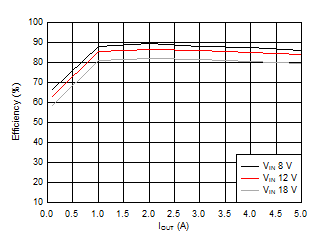
| VIN 8-18 V | EN1 = EN2 = 12 V |
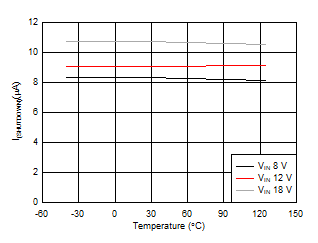
| VIN 8-18 V | EN1 = EN2 = 12 V |
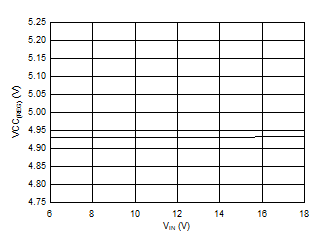
| VIN 6-18V | EN1 = EN2 = 12 V |
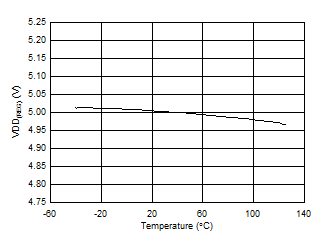
| VCC Rising | EN1 = EN2 = 12 V |
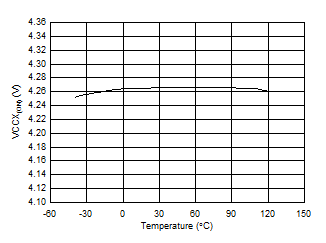
| VIN = 12 V | VCC Rising |
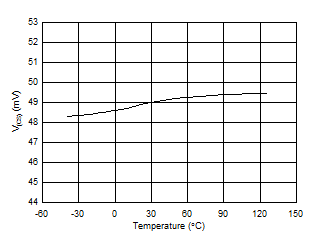
| VIN = 12 V | ILSET = GND |
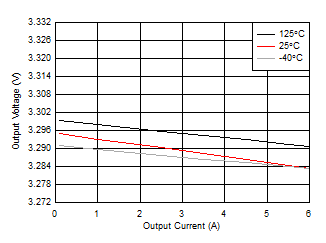
| VIN 12 V | EN1 = 12 V | EN2 = GND |
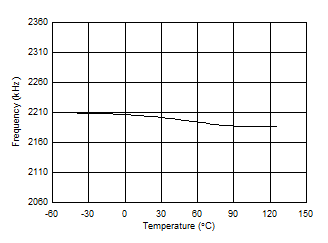
| VIN 12 V | OSC = VCC |
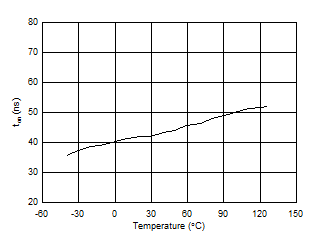
| VIN 18 V |
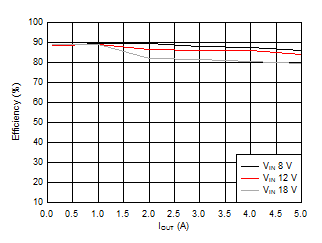
| VIN 8-18 V | EN1 = EN2 = 12 V |
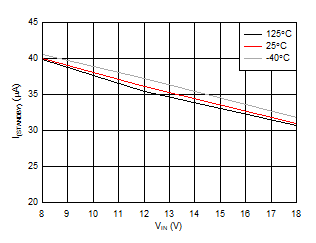
| VIN 8-18 V | EN1 = 12 V, EN2 = 0 V |
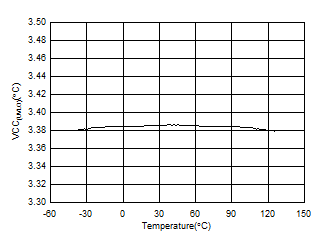
| VCC Rising | EN1 = EN2 = 12 V |
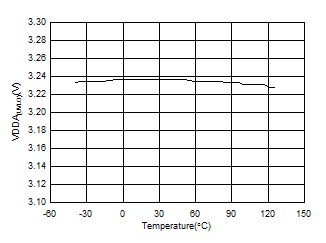
| VCC Rising |
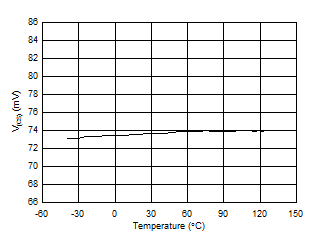
| VIN = 12 V | ILSET = VCC |
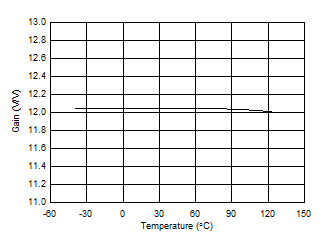
| VCC Rising |
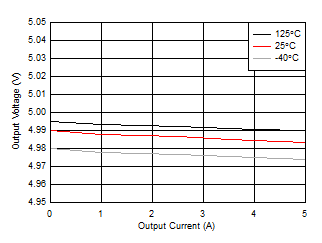
| VIN 5.5 V - 42 V | EN1 = GND | EN2 = 12 V |
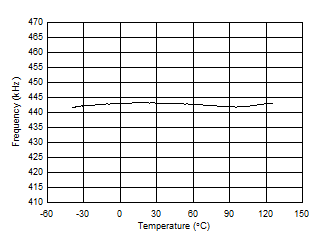
| VIN 12 V | OSC = GND |
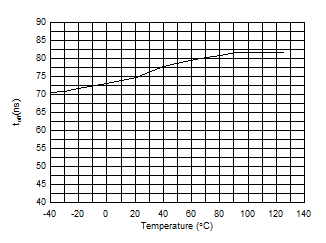
| VIN 3.8 V |